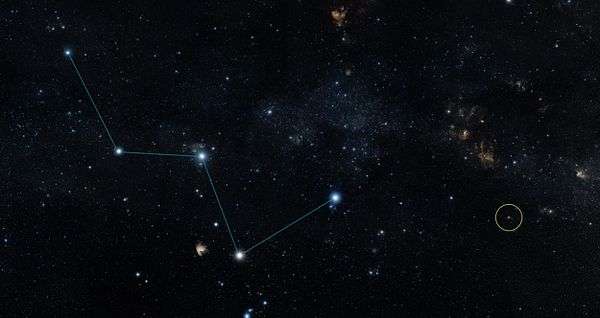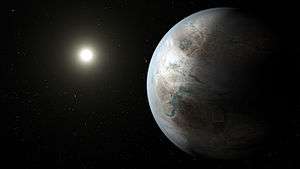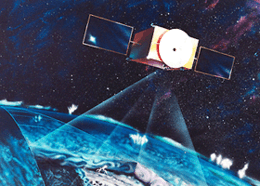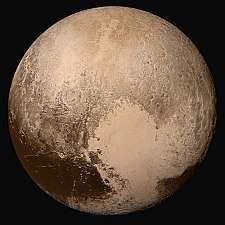HD 219134 g
| Exoplanet | List of exoplanets | |
|---|---|---|
| Parent star | ||
| Star | HR 8832 | |
| Constellation | Cassiopeia | |
| Right ascension | (α) | 23h 13m 16.97632s |
| Declination | (δ) | +57° 10′ 06.0823″ |
| Apparent magnitude | (mV) | 5.574 |
| Distance | 21.25 ly (6.52 pc) | |
| Spectral type | K3V | |
| Mass | (m) | 0.81 (± 0.03) M☉ |
| Radius | (r) | 0.778 (± 0.005) R☉ |
| Temperature | (T) | 4699 K |
| Orbital elements | ||
| Semi-major axis | (a) | 0.3753 (± 0.0004)[1] AU |
| Eccentricity | (e) | 0[1] |
| Orbital period | (P) | 94.2 (± 0.2)[1] d |
| Inclination | (i) | null[1]° |
| Physical characteristics | ||
| Mass | (m) | >10.81 (± 1.27)[1] M⊕ |
| Radius | (r) | ~2.4 R⊕ |
| Temperature | (T) | 298 K (25 °C; 77 °F)[2] |
| Discovery information | ||
| Discovery date | 2015 November 17 | |
| Discoverer(s) | HARPS-N | |
| Discovery method | radial velocity method | |
| Discovery site | La Palma, Canary Islands | |
| Discovery status | Published | |
HD 219134 g, also known as HR 8832 g, is an unconfirmed exoplanet orbiting around the K-type star HR 8832 in the constellation of Cassiopeia. It has a minimum mass of 11 Earth Masses, suggesting that it could be a high-mass ocean planet or a Neptune-like ice giant. Unlike HD 219134 b and HD 219134 c it has not been observed by the Spitzer Space Telescope and thus its radius and density are unknown. It resides near the inner edge of the system's habitable zone. If it has an Earth-like composition, it would have a radius 1.9 times that of Earth. However, since it is probably an ocean planet or Mini-Neptune, it is likely larger.
Characteristics
Mass, Radius, and Temperature
HD 219134 g is a sub-Neptune-mass exoplanet with a minimum mass of 10.81 M⊕ and an unknown radius, as it is not known to transit.[1] However, due to the high metal content of the host star, the planet might not be an ice giant. For a rock-iron composition, HD 219134 g would be about 1.9 R⊕, which seems unlikely for a planet of this mass. A more plausible rock-water composition would put the planet at about 2.4 R⊕. Depending on its composition, it could be potentially habitable, as it has an equilibrium temperature of 298 K (25 °C; 77 °F).
Orbit
HD 219134 g takes about 94.2 days to orbits its star at a distance of 0.3753 AU. This is comparable to Mercury's orbit of 88 days at about 0.38 AU. However, due to the lower luminosity of the host star, HD 219134 g is closer to Earth in terms of temperature. The eccentricity of the planet's orbit is believed to be close to zero, indicating a very circular orbit.[1]
Host Star
The planet HD 219134 g orbits the K3V orange dwarf HD 219134, also known as HR 8832. It is 79% the radius and 80% the mass of the Sun with 26% the luminosity. It has a temperature of 4699 K and is around 11 billion years old.[1] For comparison, the Sun has a temperature of 5778 K and is 4.55 billion years old.
The apparent magnitude of the star, or how bright it appears from Earth, is around 5. Therefore, it is just visible to the unaided eye to most observers.
Habitability
HD 219134 g could be a potentially habitable planet. Based on its relatively low mass (~11 M⊕) and the high metal content of the parent star (+0.11 [Fe/H]), it has a moderate chance of being an ocean planet. While these types of worlds have no solid surfaces for life to develop, it is predicted that biology would arise in ways other than that of Earth. The planet also appears to have a similar temperature to Earth, with an equilibrium temperature of 298 K (25 °C; 77 °F). However, the planet was not reported in the most recent analysis of the system with the HARPS-N spectrograph, which suggests that the planet may not actually exist.



